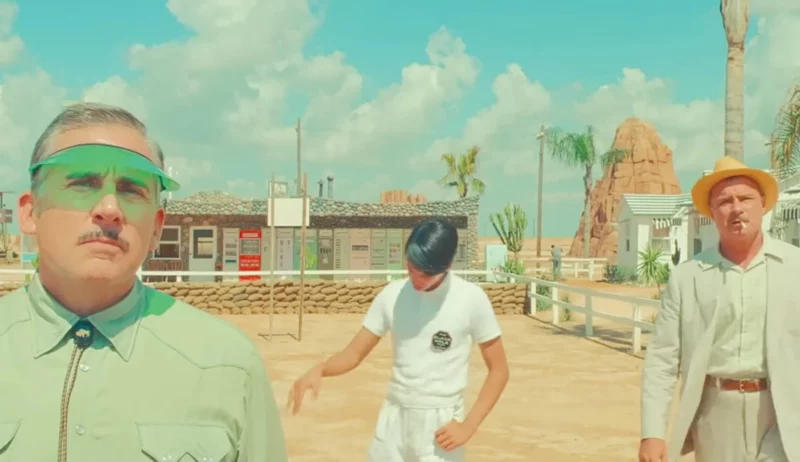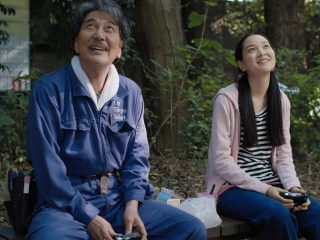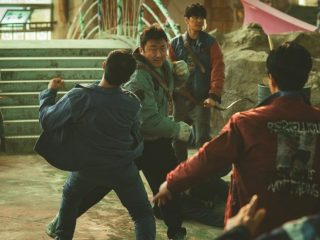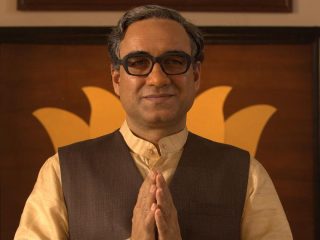Wes Anderson’s films are characterized by their delightful blend of cinema and architecture accompanied with exotic colour palettes conveying the emotional overtones of the characters. There’s a grain of eccentricity in all of his films which makes them unique. However his films deals with the issues of society and the world at large.
The Theatre of the Absurd is a Post-World War-II designation for particular plays of absurdist fiction written by a number of primarily European playwrights in the late 1950s. This style of writing was first popularized by Samuel Beckett, Arthur Adamov and Eugène Ionesco. Anderson’s Asteroid City can be placed in the same context. The film commences with a TV host introducing a televised production of a play named “Asteroid City” by a famous playwright Conrad Earp. This is a clear case of metacinema or metarealism as the TV host announces at the beginning of his introduction that, “Asteroid City doesn’t exist. It is an imaginary drama created expressly for this broadcast”. Metarealism was born in Russian poetry and art, and was first used by Mikhail Ephstein. The term refers to metaconscience which means beyond physical consciousness, beyond a subjective polarized view of reality. In all referring to the fluidity of reality, Anderson’s Asteroid City breaks the fourth wall multiple times throughout the film. The film actively blurs the lines between the play it is depicting and the film that the audience is perceiving. At times we see one of the actors playing the titular characters named Augie from the play meeting the playwright Conrad Earp asking him, “Why does Augie burn his hand on the Quicky-Griddle?” to which the playwright replies,”Well I don’t even know myself to tell you the truth”, thus depicting a sense of bewilderment, one of the chief traits of absurdist plays.
The play is set in 1950s in an Arizonian desert replete with cactuses named Asteroid City which is quite similar to the setting of Beckett’s play “Waiting for Godot” where the play opens with two bedraggled acquaintances, Vladimir and Estragon, meeting by a lifeless tree. An ensemble of characters march towards Asteroid City for Junior Stargazer Convention. The plays of the Absurd theatres focus largely on existentialism and express what happens when human existence lacks meaning or purpose and communication breaks down. The playwright, actors, characters and the director of the play all behave like the characters of absurd plays in various instances. They playwright doesn’t know what he intends to do with his play, the director of the play Schubert Green steeped in his personal crisis doesn’t have any idea regarding how the play will end and what it means to convey, the actors are weary and in a certain scene we see the actor who plays Augie during his brief interaction with the director Schubert Green tells him, “I don’t understand the play”, the characters are whimsical and quirky. A sense of disillusionment encompasses everyone in the film and the play within the film which echoes with the disillusionment that people faced after World War II when their logos was decentred, all absurdist plays reflect this predicament of modern man, later we find the famous French philosopher Derrida also talking about this flux of logos in his theory of deconstruction.
Magic realism or magical realism paints a realistic view of the world while also adding magical elements, often blurring the lines between fantasy and reality. This genré was popularized in the works of Gabriel Garcia Marquez. Traces of magic realism is found in Anderson’s Asteroid City in the appearance of the UFO above the crater from where an alien emerges and steals a fragment of the meteorite that created the crater. While the stargazer honorees and Dr Hickenlooper makes rigorous attempts to contact the alien, love blooms amidst this mess between the war photojournalist Augie and the famous actress Midge Campbell who was apparently going through a midlife crisis, between Augie’s son Woodrow and Midge’s daughter Dinah who were both members of the stargazer honorees, between the young school teacher June Douglas and Montana who was the leader of a cowboy band. However they are all tied together by a sense of grief or void which becomes evident in a certain scene between Augie and Midge, where Midge tells Augie, “I think I see how I see us… Two catastrophically wounded people who don’t express the depths of their pain because we don’t want to and That’s our connection”. Under the garb of absurdity Asteroid City unfolds the fragmented worlds of it’s playwright, actors, characters and the director of the play, Augie and his father-in law Stanley implicitly grieves over the loss of their wife and daughter, Midge grows weary of her fame and has been a victim of abuse regarding which there are no direct references but in her conversation with Augie she does mention about her past with violent men, Augie’s three daughters and his son Woodrow all try to cope up with the loss of their mother in their own ways, the director Schubert Green tries to endure the tumults of his broken marriage and the playwright Conrad Earp conceals his illicit relationship with actor who plays the titular character of Augie. Though all the characters of the play and the film are stoic in their suffering, their fragmented world makes the narrative of the film fragmented. Asteroid City has no steady or fixed narrative, it’s similar to a Godard film where there’s uncertainty looming at every step, thus perfectly representing the degenerate world.
The actions of the characters are impulsive and cannot be comprehended such as the sudden appearance of the TV host in the middle of the play telling, “Am I not in this?”, the three girls of Augie playing the role of witches casting spells, the motel manager working as a real estate agent and repeatedly asking the juice preferences of everyone in the play. Like an absurd play, the absurd in Asteroid City takes the form of man’s reaction to a world apparently without meaning or man as a puppet controlled or menaced by invisible outside forces.
The quarantine imposed by General Gibson that entraps everyone in the Asteroid City is symbolic of their entrapment in this splintered world from which they cannot break free. Vladimir and Estragon in Beckett’s Waiting for Godot seek out the meaning of their life waiting for someone unknown(Godot), who never arrives, The characters in Asteroid City similarly wait for something oblivious, searching for the purpose of their lives but ultimately they are unable to fathom it and therefore they return back to their same chaotic world.
The reappearance of the UFO to return the meteorite fragment at the moment when Gibson is about to end the quarantine followed by the raucous and anarchy created by the children, scientists and parents who revolted using honoree’s inventions to overpower military is very analogous to the circus depicted at the ending of Federico Fellini’s “Eight and Half”. In “Eight and Half”, the protagonist Guido who is a director aspires to make a science fiction film that includes thinly veiled autobiographical references but failed to make it as his desires hindered his craft, similarly in Asteroid City the playwright Conrad Earp couldn’t successfully establish what he actually wanted to depict through his three act play and an epilogue. In both the cases their creations gradually takes the form of a circus.
Anderson uses monochrome and coloured cinematography to portray the distinction between the world in the film and world of the play within the film. He used coloured cinematography to depict the play which resembles a distorted dreamland, and for an instance we wonder whether the play really have any existence or is it just a dream especially when the TV host introduces us to the special seminar scheduled at the playwright’s request where he talks about making a scene where all his characters are each gently privately seduced into the deepest, dreamiest, slumber of their lives as a result of their shared experience of a bewildering and bedazzling celestial mystery but seeks suggestions as he doesn’t know how to write it and a pupil of that seminar who later plays the character of Augie in his play stands up to reply, “You can’t wake up if you don’t fall asleep”. Anderson deliberately uses monochrome cinematography to depict the world outside the play, which is closer to the reality of our world because our life can be best summed up into equal shares of black and white.
Absurdism and Existentialism goes hand in hand, in Asteroid City existentialism is evident in Midge Campbell’s utterance,”Was I ever there?” while she was rehearsing for a film, in a certain conversation between Clifford, a junior stargazer awardee and his father J.J. Kellogg who when asks him, “Why do you always have to dare something?”, Clifford replies, “I don’t know, maybe because I’m afraid nobody will notice my existence in the universe. “. Like Midge and Clifford all the characters in someway or the other go through existential crisis in Asteroid City which is manifested through their untoward actions.
Influences of Dadaism which was an art movement of the European avant-garde society in the early 20th century( the movement consisted of artists who rejected the logic, reason of modern capitalist society instead expressing nonsense, irrationality) can be found in Anderson’s creation of this particular film.
Satyajit Ray also has a huge influence on Anderson’s direction. Anderson explicitly paid homage to Ray first in his 2007 film “Darjeeling Limited” where throughout the film he used Ray’s background score, depicted trains in the same manner Ray depicted in “The Apu Trilogy” thereby deeply rooting his film in Indian culture and philosophy similar to Ray’s filmography. In Asteroid City as well he pays tribute to Ray by recreating a scene(that particular scene of memory game played between junior stargazers) from Ray’s “Aranyer Din Ratri(1970)”.
The structure of an absurd play is circular, with the finishing point same as the starting point. Asteroid City perfectly abides by this feature of absurd plays. The play begins with Augie’s arrival to the Asteroid City with his family and ends with him leaving with his family from the Asteroid City. Both the beginning and ending of the play (similar to Beckett’s Waiting for Godot which begins with Vladimir and Estragon waiting near a tree and ends in the same manner) takes place in a cafe where Augie gives the same order, “five orders of flapjacks and a black coffee” and asks the same question, “Who needs to pee?”
Dysfunctional families, subversion of children -adult paradigm that echoes of Victorian childhood are typical features of Wes Anderson’s films. Be it Moonrise Kingdom, The Royal Tenenbaums, The Darjeeling Limited and Asteroid City we see children as victims of dysfunctional families undergoing identity crisis, trying to rediscover themselves and establish their individualism in their own way. All the junior stargazers therefore in Asteroid City delve deep into their astronomical world searching for their will to live, trying to find their purpose of life.
Asteroid City narrates a tale of cosmic wilderness, a suffering lurking in the mystery that engulfs the film but most importantly it subtly refers to nuclear threats that is being currently faced by the world through the atomic bomb tests depicted at the beginning and end of the play. Though Anderson’s Asteroid City is severely Post-Modern yet it’s a delightful venture into the world of science fiction.











